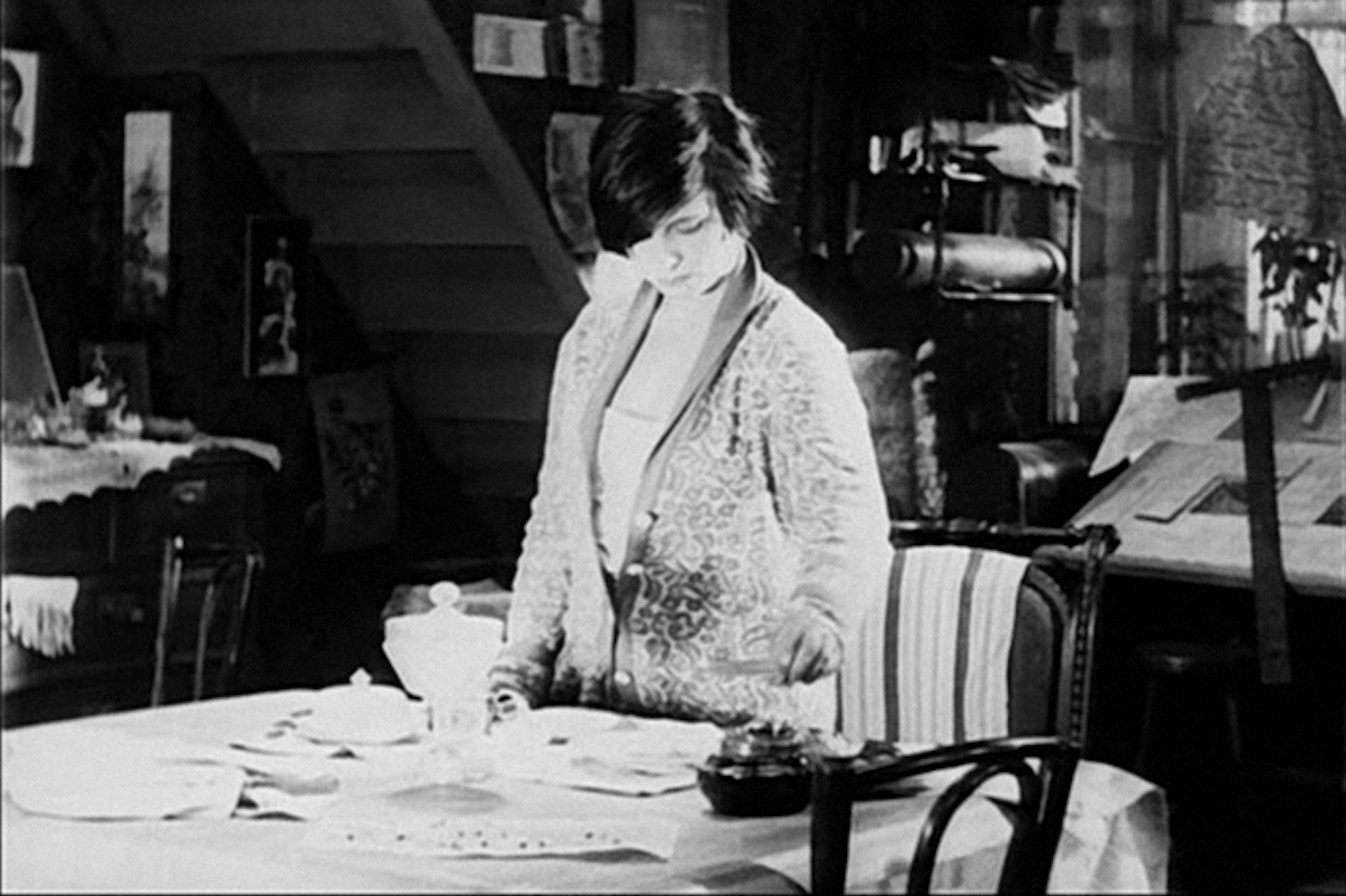“Bed and Sofa (Tret’ia Meshchanskaia)” Interior (1927)
Artist/Designer: Abram Room, Sergei Iutkevich, Viktor Shklovsky, Grigorii Giber, Lenfilm
Project Location: Moscow, Russia

Style/Period(s):
No Style/Period Assigned.
Primary Material(s):
Ceramic, Fabric, Textile, Wood, Wall Paper, Paper, Light, Electronics, Plants, Water
Function(s):
Residential Structure, Entertainment, Film/TV Set
Related Website(s):
Significant Date(s):
1920, 1927
Additional Information:
Publications/Texts in Print:
Kirkham, Pat, Sarah A. Lichtman, and Eleanor Rees. “Comfort and the Domestic Interior in Soviet Fiction Cinema of the 1920s.” Essay. In Screen Interiors: From Country Houses to Cosmic Heterotopias, 31–36. London: Bloomsbury Visual Arts, 2021.
Abram Room, "Moi kinoubezhdeniia"["My Cinema Convictions"], Sovetskii ekran [Soviet Screen] 8 (1926):5; Room, "'Tret'ia Meshchanskaia,'"2.
Abram Room, "'Tret'ia Meshchanskaia.' (beseda s rexhisserom A.M. Roomom)"["'Tret'ia Meshchanskaia.' (A Conversation with the Director A. M. Room)"],Kino [Cinema], September 1, 1926, 1-2.
Other films include Ermler's Katka's Reinette Apples (Kat'ka-bumazhnyi ranet, 1926), Mark Donskoi's In the Big City (V bol'shom gorode, 1927), and Barnet's The House on Trubnaia (Dom na Trubnoi,1928).
Julian Graffy, Bed and Sofa: The Film Companion (London and New York: I.B. Tauris, 2001), 14-15. Graffy's book provides a detailed study of the film.
Graffy, Bed and Sofa, 15.
Graffy, Bed and Sofa, 20.
Sergei Iutkevich, Chelovek na ekrane: Chetyre besedy o kinoiskusstve: Dnevnik rezhissera [Man on the Screen: Four Conversations about Cinema Art: The Diary of a Director] (Moscow: Goskinoizdat, 1947), 322.
Iutkevich, Chelovek na ekrane, 322.
Graffy, Bed and Sofa, 15.
Graffy, Bed and Sofa, 16.
For discussion of the film's sets, see Emma Widdis, "Faktura: Depth and Surface in Early Soviet Set Design," Studies in Russian and Soviet Cinema 3, no. 1 (2009): 14-24.
Iutkevich, Chelovek na ekrane, 135.
Room, "'Tret'ia Meshchanskaia,'" 1-2.
Khrisanf Khersonskii, "Bor'ba faktov, vzgliadov, idei i sposobov vozdeistviia" ["The Struggle of Facts, Visions, Ideas and Leverage"], Kino-front [Cinema-font] 9-10(1926): 21-6; K. Denisov, "Meshchanstvo v kino" ["Meshchanstvo in Cinema"], Sovetskii ekran [Soviet Screen] 5 (1927):3.
Catriona Kelly, Refining Russia: Advice Literature, Popular Culture and Gender from Catherine to Yeltsin (Oxford: Oxford University Press, 2001), 160-1; Buchli, Archaeology of Socialism, 58.
For detailed discussion of the negative connotations of the apartment's objects, see Graffy, Bed and Sofa, 26-8.
Abram Room, "Moi kinoubezhdeniia" ["My Cinema Convictions"], Sovetskii ekran [Soviet Screen] 8 (1926): 5; Room, "Tret'ia Meshchanskaia,'"2.
Walter Benjamin, The Arcades Project, ed. Rolf Tiedemann, trans. Howard Eiland and Kevin McLaughlin (Cambridge, MA, and London: Belknap Press, 2002), 216.
Philip Cavendish, Soviet Mainstream Cinematography: The Silent Era (London: UCL Arts & Humanities Publications, 2007), 71.
Graffy, Bed and Sofa, 34.
Graffy, Bed and Sofa, 34.
Graffy, Bed and Sofa, 31.
Benjamin, Arcades, 200.
Cavendish, Soviet Mainstream Cinematography, 79.
Cavendish, Soviet Mainstream Cinematography, 79-80.
Benjamin, Arcades, 220-1.
Walter Benjamin, "Moscow Diary" [1927], October 35 (Winter 1985): 4.
Graffy, Bed and Sofa, 28: Le Corbusier, L'art décoratif d'aujord'hui [The Decorative Art of Today] (Paris: Editions Crès, 1925; Paris: Arthaud, 1980), 91. Citations refer to the Arthaud edition.
Cavendish, Soviet Mainstream Cinematography, 84.
Building Address: Moscow, Russia
Significant Dates: Released on March 15, 1927. Made in mid- to late 1920s.
Supporting Staff/ Designers: Abram Room (director and writer), Viktor Shklovsky (formalist theorist/ co-writer), Sergei Iutkevich (set designer), Grigorii Giber (camera operator), and produced by Sovikno Studio
Tags: Soviet cinema, contemporary Moscow, silent film, Soviet housing problem, Soviet fiction film, aesthetic economy
Viewers should treat all images as copyrighted and refer to each image's links for copyright information.